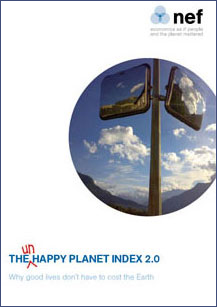Other Indicators of Social Well-Being
The Genuine Progress Indicator is not the only approach to measure, quantify, and track social well-being. The following are a handful of socially and academically accepted alternatives, though each comes with its own strengths and weaknesses.
Happy Planet Index
 The Happy Planet Index (HPI) was developed by the New Economy Foundation (NEF) with support from Friends of the Earth. At its core, the HPI argues that long and happy lives must be the economys ultimate goal and not merely insatiable economic activity. It recognizes that all material goods begin with planetary resources, and are then altered into products, processes, and services.
The Happy Planet Index (HPI) was developed by the New Economy Foundation (NEF) with support from Friends of the Earth. At its core, the HPI argues that long and happy lives must be the economys ultimate goal and not merely insatiable economic activity. It recognizes that all material goods begin with planetary resources, and are then altered into products, processes, and services.
To calculate the HPI, authors use the following equation: Life Satisfaction times Life Expectancy divided by the communitys Ecological Footprint. Life Satisfaction is determined via questionnaires, polling, and other self-reporting methods. Life Expectancy is the average life expectancy of a nation or community, and it too provides an important perspective. Longer lives are usually associated with a nations healthcare system, low infant mortality, less stress, and general safety. The product of both terms equates into what Dutch sociologist Ruut Veenhoven calls happy life years.
The denominator in the equation is the Ecological Footprint, a long-standing and generally accepted measure of calculating whether the needs and demands of a communitys activity is within or extends beyond the ability of nature to provide requisite products and services. Globally, the Ecological Footprint indicates that humans are harvesting and depleting natural capital faster than earths ability to regenerate products and assimilate pollution and waste. Using these terms and calculating nations HPI, authors identify a Reasonable Ideal HPI as 83.5, though each term can vary and still attain a similar quotient. The latest assessment calculated the United States as having a score of 30.7.
Gross National Happiness
The Gross National Happiness (GNH) is one of many matrices that attempt to quantify in psychological terms general wellbeing. The GNH was created in the country of Bhutan in the early 1970s and is predicated on the spiritual values of Buddhism. The GNH was developed primarily to offer a subjective reality check to traditional economic indicators by injecting societal and individual happiness.
The fundamental principles of the GNH are social equity and opportunity, healthy natural environment, and sound governance.
More recent development of the GNH lay out seven categories of wellness: economic, environmental, physical, mental, workplace, social, and political. What really sets the GNH from the GDP is how the metric is calculated. Rather than collecting objective data, the GNH is measured by surveys through what is called the day reconstruction method. Briefly, respondents are asked about their feelings and recollections of a given day, individuals rank their happiness on a scale from one to six, and those tallies are averaged over the day in various categories. A similar approach is the premise for research focusing on subjective wellbeing, which simply asks respondents Are you happy? on a wide array of societal topics. An associate director at the National Institute on Aging stated, A national wellbeing account, similar to the [GDP], would give us a better understanding of how changes in policy and social trends affect quality of life.
Subjective Measures of Human Wellness
On the extreme opposite of the GDP is the purely subjective assessment of human wellness. Such approaches unapologetically disregard cold numbers as a proxy for human improvement, and instead respect and provide a framework for the most fundamental of peoples needs. A good place to start the discussion of appreciating human wellness is Abraham Maslows oft-cited hierarchy of needs. His hierarchy builds upon the most fundamental requirements for life, Physiological, and its continuation, Safety. Next are emotional elements that provide happiness, family, and community, Love/Belonging and then Esteem, culminating in the final step of Self-Actualization.
Expanding Maslows fundamental principles, Manfred Max-Neef developed his Matrix of Human Needs. No longer five tiers, Manfreds Matrix consists of nine Axiological Categories of gradual enlightenment, ranging from Subsistence to Affection to Creation and ultimately Freedom. The critical point is how little material purchasing and consumption matters in the broad spectrum of human needs. And yet, it is manufacturing and acquiring that guides so many assessments of todays society and polity.
Continuing the progression from economic pursuit to human improvement is Amartya Sen and Martha Nussbaums concept of Capabilities. Individuals and societies should not be evaluated on measures of utility and other indicators of material access. Instead, the Capabilities approach is predicated on recognizing elements such as existence, health, protection, and prosperity as freedoms. For example, poverty should not be thought of as a lack of economic access but rather being deprived of a fundamental, inalienable freedom.
There are endless others that are relevant and insightful, not the least of which being John Rawls Theory of Justice and his veil of ignorance. Our attempt is to present a few subjective alternatives of measuring improvement and prosperity to the more objective data of traditional indicators of mere economic exchange.